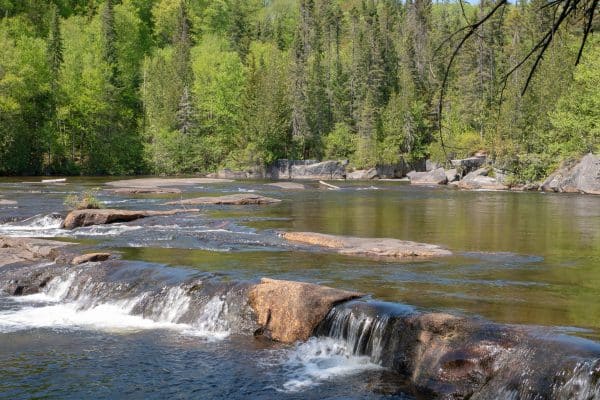- Research
-
YOU ARE
- Community member
- Future Student
- Student
- Professor
- Alumni
- Media
- Guidance counsellors
- INRS retiree
- Contact Us
- Newsroom
- Careers
- FR
-
Studies
We teach the next generation of researchers to develop scientific, social, and technological innovations.
-
Research
We find solutions through interdisciplinary research and industry or public and community partnerships.
-
INRS
We play an active role in Québec's economic, social, and cultural development.
An INRS team is studying the dynamics of plants and erosion in a unique facility in North America.

This flume was created for the design and optimization of coastal protection, but also understanding the fundamental processes governing Quebec shorelines. | Photo: INRS
Recreating a 60-meter marsh with nearly 7,000 plants in a laboratory may seem impossible, but the wave flume of the Institut national de la recherche scientifique (INRS) is the only place in North America capable of meeting this challenge. This flume was created for the design and optimization of coastal protection, but also understanding the fundamental processes governing Quebec shorelines.
Professors Jacob Stolle and Damien Pham Van Bang, co-scientific directors of the Environmental Hydraulics Laboratory, based in Quebec City, are working on a prototype salt marsh ecosystem to protect Canada’s coastline from erosion. They have been awarded a $392,571 grant from the National Research Council of Canada (NRC) Collaborative Research and Development Grants Program (CRD) to carry out this large-scale project over the next few years.
“This NRC-funded project will allow us to better understand the interaction between waves and vegetation to protect shorelines in Quebec,” says Professor Jacob Stolle, the project’s main researcher.
“The idea is to better understand how to protect and stabilize the coastal environment with Canadian salt marshes.”
Jacob Stolle, professor at INRS
A marsh “under the microscope”
This study will be the first to focus on specific plant species in Canada. It will aim to model the entire marsh platform in a laboratory setting. Additionally, the study will examine how individual plant dynamics contribute to the behaviour of the marsh as a whole.
The research will be divided into several phases. The team recently finalized the first set of experiments over the summer which observed the growth of plants based on their height on the bank. In Spring 2022, they plan to recreate this natural environment on a large scale to see what level of protection a salt marsh ecosystem provides in storm events.
“There are a few methods to protect coastlines using plants. The plants act to dissipate the wave energy and reduce the currents in the marsh,” explains Professor Stolle. The root system also plays a sediment-stabilizing role.”
Nature-based solutions
The coastal environment is an important part of the Canadian landscape and an important driver of the federal economy. Pressure on these environments from urban intensification and climate change has increased the risk of flooding and erosion and has had significant impacts on habitats and coastal ecosystems.
Natural coastal systems, such as coastal marshes, mangroves, and coral reefs, are increasingly recognized for providing “natural protection” against flooding, climate resilience, and shoreline stabilization.
The federal and provincial governments have recognized these benefits and have worked to develop standards that govern the implementation of natural systems as coastal protection systems.
“We are trying to better understand how this ecosystem, which is already a natural coastal protection, works so that we can optimize it.”
Damien Pham Van Bang, professor at INRS

“Our goal is to bring out technologies and solutions for shoreline protection using these natural mechanisms,” concludes Professor Pham Van Bang.
You may also like
Share



